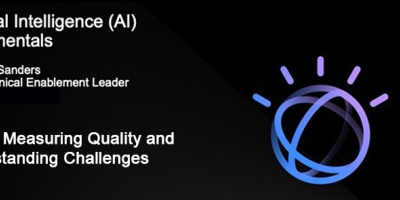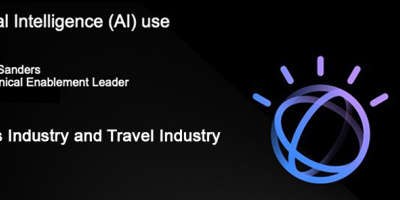One of the favorite go-to arguments of AI naysayers is how many jobs AI apps will soon destroy.
In the spirit of starting a hopeful new year, it might be good to survey the AI scene with a little more optimism to see that AI can create more and better jobs than those it eliminates.
Predictions about the negative impact of AI apps, particularly the large language model (LLM) types like ChatGPT, are probably the easiest type of article to find in today’s media landscape. To hear some tell the story, 10 years from now half the US and EU population will likely be chronically unemployed because AI apps will be doing everything more quickly and more cheaply than human labor can. What many people don’t stop to think about is that this is a lot like asking an early 20th-century carriage manufacturer what he thinks of the Wright Brothers and expecting that opinion to apply universally.
A fairly typical example is a study released in November 2023 by the UK Department of Education (not that the US has no similar examples, but just to show this is not a strictly “American” phenomenon), which analyzed 365 job categories most likely to fall by the wayside in the next few years because of AI. Most likely to wither because of LLMs specifically, the study found, were telephone salespeople, general salespeople, psychologists, “further education” teaching professionals, and stock traders and their assistants. Likely to disappear because of AI apps in general were additionally identified management consultants, business analysts, financial managers, accountants, and purchasing managers, with non-lawyer legal professionals also in the top 10. Manual laborers (including parking valets) and laborers with specific technical skills (plasterers, steel erectors, roofers) were judged safest from AI obsolescence for now.
Not So Fast, Folks
In contrast, a report on the future of jobs published by the World Economic Forum (WEF) in April 2023 provides a different perspective.
“The employment of data analysts and scientists, big data specialists, AI machine-learning specialists and cybersecurity professionals is expected to grow on average by 30 percent by 2027. Training workers to utilize AI and big data will be prioritized by 42 percent of surveyed companies in the next five years, ranking behind analytical thinking (48 percent) and creative thinking (43 percent) in importance,” a report summary notes. This is primarily due to the report identifying information and data processing as the task group likely to be automated most significantly over the next few years.
The McKinsey Global Institute issued a report on Generative AI and the Future of Work in America in July 2023 that predicted automation of up to 30 percent of all work activities by 2030, attributing most of that to the influence of AI, particularly via “generative AI enhancing the way STEM [science, technology, engineering, and mathematics], creative, business, and legal professionals work rather than eliminating a significant number of jobs outright.” Specifically, this report noted that “generative AI can be used to write code, design products, create marketing content and strategies, streamline operations, analyze legal documents, provide customer services via chat bots, and even accelerate scientific discovery.” The report further estimated that without generative AI, automation would have been expected to automate just 21.5 percent of hours worked in the US economy rather than the up to 30 percent the report said was expected.
Fueling the Fire: AI-Related Jobs Themselves
The field of AI itself offers a number of job titles that have only become available in the last few years, and demand for all of them seems certain to provide an escalating number of jobholders between now and 2030. With additional training and experience, perhaps from freelance side jobs, current and aspiring IT workers may find themselves able to qualify for them soon. Unsurprisingly, a recent study by the University of Oxford in the UK found that workers with AI-related skills can already earn from 21 to 40 percent higher salaries than those who don’t.
Data scientists would be a logical first thought for an AI-related career shift. The processes of collecting and analyzing data, using or inventing data visualization techniques for data interpretation, and creating predictive algorithms and machine-learning (ML) models will be skills undoubtedly in demand as AI is called on to automate more tasks.
As the WEF study indicated, cybersecurity is going to be hot. Information is a commodity, and value invites theft. Commodities handled on the large scale that AI looks to provide are a growing target.
AI research scientists work alongside data scientists to gather data, train models, and report results as they create new systems that mimic human brain functions.
AI ethics consultants will be needed to help root out unconscious bias in learning models and AI app training data, as well as to keep an eye on system conformance with laws and regulations governing AI apps and their use. That’s a field that will surely be burgeoning as unscrupulous actors invent new ways of unfairly exploiting AI capabilities.
ML engineers will be crucial in developing new ways of training AI systems and squeezing new efficiencies out of existing ML protocols. As demand for AI use increases, so will the need for faster training of AI apps to bring them online ahead of competitors.
AI solutions architects will be in demand to help coordinate between other AI roles, manage AI data pipelines and related workflows, oversee execution of data initiatives, and research AI technology changes developed by other entities to find new tools of use to the architects’ own organizations.
Software engineers must continue do the nut-and-bolts job of designing software, reviewing code (if not generating), testing for quality-standard maintenance, ensuring sufficient security for apps, and at least reviewing (if not writing) app documentation.
Data analysts will still be needed to be sure the processes of translating data into business information are properly carried out. Cleansing, organization, quality assurance, and perhaps even procurement of data are the basic building blocks of any AI system.
“Big data” engineers specialize in administering and generating outcomes from organizations with large data stores. Big data environments call for thinking outside the relational database box, keeping current on technical tools for efficiently manipulating large amounts of data, and particularly today being proficient in languages such as Java, Python, and R, as well as tools like Apache Spark and SQL.
Business intelligence (BI) developers will have a role to play in analyzing information generated by one or more AI algorithms and massaging it all to be of most value to the end users and executives who will rely on a digest of BI output.
Data mining and general research specialists will be in demand to carry out strategic data analysis, identify ways in which statistical analysis and modeling can create new efficiencies, and remain informed of new methodologies and techniques, both in related fields and among different groups working with data and AI within their own enterprises.
Natural Language Processing (NLP) is a function that will need its own specialists. Computer systems need to understand the human language of queries as much as humans need to understand AI results. NLP engineers will also provide knowledge of using large datasets to train machine models, provide the ability to create new modeling techniques, and stay abreast of NLP developments throughout their respective industries.
AI will also require prompt engineers to help less-technical business users enter instructions to get the valid results those users need to make strategic decisions. These engineers also help improve AI-generated responses to achieve greater clarity, tweak ML algorithms to enable the most accurate and effective use, and massage the crucial balance between control and intent in AI inputs and outputs.
As is already true for any software tool end users must access to achieve desired business results, UX (user experience) engineers will be needed to facilitate correct and convenient user interpretation of algorithm results from the eventual millions of AI apps that will find their way to user screens over the next few years.
Computer vision engineers will have to oversee analysis and accurate extraction of data from images and videos, a major source of information and ML training, use of which is already spreading vigorously.
AI product managers will surely be in demand as AI apps expand beyond internal use by individual organizations and move into the already well-defined realm of becoming off-the-shelf software products for general sale. These workers will be responsible for spotting gaps in the AI software market, having the marketing savvy to predict future trends and better ways of meeting existing trends, and providing the vision to see how AI apps can solve new problems in ways competitors haven’t yet conceived.
Finally, robotics engineers will have an important place in identifying and remedying difficulties between robotic equipment and the algorithms that operate them, designing and building prototype machines, and perhaps overseeing either human or robotic technicians needed to maintain algorithm-driven industrial equipment.
Preparing for the Best Outcomes
Workers who have at least 10 years remaining in their careers but who aren’t in IT or AI already can sidestep into being power users of AI by reading about the technology, tinkering with the online versions of AI apps offered by some of the major producers, and taking on side gigs that give them some opportunity to use AI apps in some form. Ask if there isn’t some way a chatbot or AI in some other form could be used, even in a limited way, to do a job someone is already doing. Try to focus on the human context of AI’s impact and how that might be beneficially modified.
Workers with more than 10 years remaining in their prospective work lives can use these methods, take advantage of online or work-related “further education” opportunities, or return to school for formal training in IT-related degree programs. Some forward-thinking institutions already offer formal degree programs in AI, ML, robotics, or other AI specialties. It seems likely that wherever that isn’t the case, multiple programs catering to specific AI skills are already on the minds of college and university curriculum planners, and more will be appearing with each academic year.
A bottom-line way to prepare for an AI future may be to simply stop thinking about Skynet whenever someone mentions AI and instead think about the huge bundle of employment opportunities that the inevitable advances AI will create in the next decade and beyond.























 More than ever, there is a demand for IT to deliver innovation. Your IBM i has been an essential part of your business operations for years. However, your organization may struggle to maintain the current system and implement new projects. The thousands of customers we've worked with and surveyed state that expectations regarding the digital footprint and vision of the company are not aligned with the current IT environment.
More than ever, there is a demand for IT to deliver innovation. Your IBM i has been an essential part of your business operations for years. However, your organization may struggle to maintain the current system and implement new projects. The thousands of customers we've worked with and surveyed state that expectations regarding the digital footprint and vision of the company are not aligned with the current IT environment. TRY the one package that solves all your document design and printing challenges on all your platforms. Produce bar code labels, electronic forms, ad hoc reports, and RFID tags – without programming! MarkMagic is the only document design and print solution that combines report writing, WYSIWYG label and forms design, and conditional printing in one integrated product. Make sure your data survives when catastrophe hits. Request your trial now! Request Now.
TRY the one package that solves all your document design and printing challenges on all your platforms. Produce bar code labels, electronic forms, ad hoc reports, and RFID tags – without programming! MarkMagic is the only document design and print solution that combines report writing, WYSIWYG label and forms design, and conditional printing in one integrated product. Make sure your data survives when catastrophe hits. Request your trial now! Request Now. Forms of ransomware has been around for over 30 years, and with more and more organizations suffering attacks each year, it continues to endure. What has made ransomware such a durable threat and what is the best way to combat it? In order to prevent ransomware, organizations must first understand how it works.
Forms of ransomware has been around for over 30 years, and with more and more organizations suffering attacks each year, it continues to endure. What has made ransomware such a durable threat and what is the best way to combat it? In order to prevent ransomware, organizations must first understand how it works. Disaster protection is vital to every business. Yet, it often consists of patched together procedures that are prone to error. From automatic backups to data encryption to media management, Robot automates the routine (yet often complex) tasks of iSeries backup and recovery, saving you time and money and making the process safer and more reliable. Automate your backups with the Robot Backup and Recovery Solution. Key features include:
Disaster protection is vital to every business. Yet, it often consists of patched together procedures that are prone to error. From automatic backups to data encryption to media management, Robot automates the routine (yet often complex) tasks of iSeries backup and recovery, saving you time and money and making the process safer and more reliable. Automate your backups with the Robot Backup and Recovery Solution. Key features include: Business users want new applications now. Market and regulatory pressures require faster application updates and delivery into production. Your IBM i developers may be approaching retirement, and you see no sure way to fill their positions with experienced developers. In addition, you may be caught between maintaining your existing applications and the uncertainty of moving to something new.
Business users want new applications now. Market and regulatory pressures require faster application updates and delivery into production. Your IBM i developers may be approaching retirement, and you see no sure way to fill their positions with experienced developers. In addition, you may be caught between maintaining your existing applications and the uncertainty of moving to something new. IT managers hoping to find new IBM i talent are discovering that the pool of experienced RPG programmers and operators or administrators with intimate knowledge of the operating system and the applications that run on it is small. This begs the question: How will you manage the platform that supports such a big part of your business? This guide offers strategies and software suggestions to help you plan IT staffing and resources and smooth the transition after your AS/400 talent retires. Read on to learn:
IT managers hoping to find new IBM i talent are discovering that the pool of experienced RPG programmers and operators or administrators with intimate knowledge of the operating system and the applications that run on it is small. This begs the question: How will you manage the platform that supports such a big part of your business? This guide offers strategies and software suggestions to help you plan IT staffing and resources and smooth the transition after your AS/400 talent retires. Read on to learn:
LATEST COMMENTS
MC Press Online